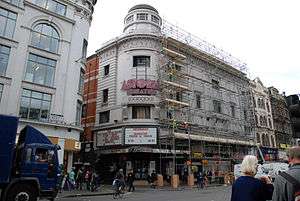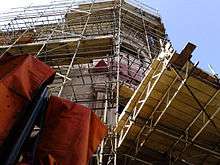London Astoria
|
The front of the Astoria prior to demolition | |
| Location |
Charing Cross Road, Soho London, WC2 United Kingdom |
|---|---|
| Coordinates | 51°30′57″N 0°7′50″W / 51.51583°N 0.13056°WCoordinates: 51°30′57″N 0°7′50″W / 51.51583°N 0.13056°W |
| Public transit |
|
| Owner | Festival Republic |
| Capacity | 1,600 – 2,000 |
| Opened | 1976 |
| Closed | 15 January 2009 |
| Website | |
| festivalrepublic.com | |
The London Astoria was a music venue, located at 157 Charing Cross Road, in London, England. It had been leased and run by Festival Republic since 2000. It was closed on 15 January 2009 and has since been demolished. The venue is still seen today as an iconic music establishment, as it helped to launch the careers of many British rock bands and also played a part in the UK success of many international acts. It was also a famous venue in Britain's LGBT scene, for holding London's biggest gay new year parties along with G-A-Y.
Originally a warehouse during the 1920s, the building became a cinema and ballroom. It was converted for use as a theatre in the 1970s. After further conversion, the building re-opened in the mid-1980s, as a night club and live music venue for well-known musical acts. There were half a dozen smaller music and gay clubs in the adjacent buildings within the neighbourhood.
In 2009 the venue closed, and was demolished as part of the development plans of the Crossrail project.
History
The Astoria was built on the site of a former Crosse & Blackwell warehouse[1] and opened in 1927 as a cinema. It was designed by Edward A. Stone, who also designed subsequent Astoria venues at Brixton (now the Brixton Academy), Old Kent Road, Finsbury Park and Streatham. When first constructed, the building was four storeys tall with a decorative frieze cornice surrounding its exterior. The original interior was styled as a square Proscenium theatre consisting of a panelled barrel-vault ceiling supported by large columns, a viewing balcony and had false viewing boxes, which actually contained the organ pipes. From 1928, the basement was used as a ballroom dancing salon.[2]
The venue's interior was re-designed with a plainer, modern style in 1968. In 1977 it was converted for theatrical use. The venue went through another period of conversion when the theatre closed in 1984. It reopened in 1985 as a nightclub and live music venue with a capacity for 2,000 people. A booklet was published called The History of the Astoria by Nigel Crewe to commemorate its evolving uses.[3] It was the venue for the last live performance by Richey Edwards of Manic Street Preachers. Mean Fiddler acquired the lease for the London Astoria in May 2000, "securing the future of live music at one of London’s most famous rock ‘n’ roll venues." It was also connected to Astoria 2 so that the two venues could function as a single venue when needed. The Astoria continued to operate in this format until its ultimate closure in 2009.
Recordings
- Radiohead recorded a whole concert and released it on VHS on 27 May 1994 under the title Live at the Astoria and they later re-released it on DVD on 21 November 2005 in the UK and one day later in USA and Canada.
- The Smashing Pumpkins recorded and filmed the live performances of their songs "Soma" and "Silverfuck" in February 1994. These videos and recordings appears on Vieuphoria DVD and the Earphoria CD.
- The Cranberries recorded a concert on 14 January 1994 and they later released it on DVD in 2005.
- The Groundhogs recorded their Live At The Astoria album at the venue in 1999.
- Feeder recorded a matinee show with a live audience in 1999 at the venue to be shown on Fuji TV, a Japanese television station. ITV2 later showed the performance in the United Kingdom. They also returned on 18 November 2008 playing their last ever show as an Echo Label artist, alongside being their last performance at the venue.
- Okean Elzy's videoclip "Toi den'" was filmed at The Astoria in February 2000.
- The video for Silver Ginger 5's "Sonic Shake" was filmed at The Astoria in December 2000.
- Sum 41 recorded a whole live concert on the DVD Introduction To Destruction in 2001.
- Steve Marriott Memorial CD and DVD was recorded in 2001 featuring Paul Weller and Noel Gallagher.
- The live portion of the video for The Wildhearts' "Stormy In The North, Karma In The South" was filmed at The Astoria in 2002.
- New Model Army recorded their DVD Live 161203 in 2003.
- The Darkness was filmed for a Channel 4 documentary called 'Carling Homecoming' where they played the venue, after being signed. They had previously been one of the first bands to sell out the Astoria without being on a major label, a turning point in the band's career to reaching superstardom.[4]
- Metallica played a secret gig in 1995 at Astoria 2. There was a limited CD release to fans.[5]
- Uriah Heep recorded their Magic Night CD/DVD at the Astoria on 8 November 2003.
- Twisted Sister recorded a Live at the Astoria DVD in 2004, which was released in 2008.
- Marillion recorded their live DVD Marbles on the Road at two sold out shows at the Astoria in July 2004.
- Dio recorded their Holy Diver – Live album at the Astoria in 2005.
- Black Label Society recorded part of their live DVD The European Invasion - Doom Troopin' Live at the Astoria in June 2005.
- Hard-Fi's DVD In Operation is a full live performance at one of their sold-out shows at the Astoria during their December 2005 tour. It reached #62 in the UK Chart as it was bundled with a remix CD, thus making it eligible.
- InMe recorded their 2006 live album and DVD Caught: White Butterfly at the Astoria in December 2005.
- Deep Purple started their Rapture of the Deep tour at the Astoria on 17 January 2006.
- Eels recorded their album Live and in Person! London 2006 at the Astoria in 2006.
- Steve Vai recorded and released a live DVD called Live at the Astoria.
- Diamond Head recorded a DVD and live CD To The Devil His Due, released by Secret Records Ltd in 2006.
- Stop The War Live DVD was recorded here featuring Mick Jones, Brian Eno and Rachid Taha.
- Tangerine Dream recorded a whole concert on 20 April 2007 and released the DVD London Astoria Club Concert 2007. A previous concert was also recorded here on 15 February 2003 and released as Tangerine Tree Volumes 32 and 33. Tangerine Tree is a non-profit fan-based project which features many audience-recorded concerts by Tangerine Dream spanning their entire career.
- Ladytron recorded their album Live at London Astoria 16.07.08 at the Astoria in 2008.
- Nirvana used two songs from the recordings made by Craig Montgomery from their 12/3/89 show on the live compilation album From the Muddy Banks of the Wishkah released 1 October 1996. They are the only recordings on the album to feature drummer Chad Channing.
- Less Than Jake recorded their album Live From Astoria on the third night of a three-day run at the venue in April 2001. It was released April 29th 2016 via Rude Records and Saint November Records (for the UK vinyl).
- Black Stone Cherry recorded the live album Live At The Astoria, London (31.10.2007) at the Astoria in 2007.
Closure



The Astoria was sold in June 2006 by Compco Holdings to property group Derwent Valley Central for £23.75m, who were rumoured to be planning to convert the site into a combination of shops, flats and offices to take advantage of an increase in property prices for the 2012 Olympics.[6]
On 13 August 2007, Festival Republic sold most of its venues and the rights to the name Mean Fiddler to the MAMA group, however it retained The Astoria and Mean Fiddler, which reverted to its old name of The Astoria 2, generally known as the LA2 (London Astoria 2). In December 2008, Coheed and Cambria played for four nights, as part of their Neverender, the only venue to feature outside of the United States.
In January 2009 the property was compulsory purchased for the Crossrail development, despite public opposition and an online petition. Former London Mayor Ken Livingstone confirmed that the venue "can't be saved".[7]
The nightclub G-A-Y left the Astoria in July 2008 and moved to the Heaven nightclub. The Astoria hosted its final night on 14 January 2009, co-organised by Get Cape Wear Cape Fly's Sam Duckworth in aid of Billy Bragg's Jail Guitar Doors charity and Love Music Hate Racism. Acts included The Automatic, My Vitriol and ex-Mansun singer Paul Draper, Frank Turner, ...And You Will Know Us By The Trail Of Dead and The King Blues. London Astoria 2 also had a closing party, headlined by rock band Open The Skies, with support from Outcry Fire, F.A.T.E and Orakai.[8]
By October 2009, the venue had been demolished completely.
A replacement for the Astoria was being developed by the council and leaseholders, depending on Government funding. Festival Republic (the owners of the Astoria) have confirmed that a replacement will be built in the near future.
In 2012, Nimax's plans to build a new theatre in the Astoria's site were approved.[9] It is unknown whether the theatre will be used for music as well as dramatic purposes. The former site of the Astoria cannot be built upon until 2017 due to the site being needed for Crossrail.
References
- ↑ Archived 26 March 2010 at the Wayback Machine.
- ↑ "Astoria (London) – The Theatres Trust". Retrieved 19 January 2010.
- ↑ "The Astoria Theatre, 157, Charing Cross Road, London, WC2". Arthurlloyd.co.uk. Retrieved 2016-02-15.
- ↑ "The Darkness – Astoria Documentary part 3/4". YouTube. 2010-01-07. Retrieved 2014-06-20.
- ↑ "Metallica - The Secret Gig With New Songs (CD, Album)". Discogs.com. 1995-08-23. Retrieved 2016-02-15.
- ↑ London's Astoria Theatre Bought by Derwent Valley | Europe > Western Europe from AllBusiness.com Archived 3 March 2008 at the Wayback Machine.
- ↑ Hoyle, Ben (2008-03-14). "'Astoria makes way for Crossrail". London: The Times. Retrieved 2008-03-14.
- ↑ Ian Winwood. "The Astoria: Share your beer-stained memories | Music". The Guardian. Retrieved 2016-02-15.
- ↑ "New Theatre Approved For Astoria Site". Londonist. 2012-04-20. Retrieved 2014-06-20.
External links
| Wikimedia Commons has media related to London Astoria. |
